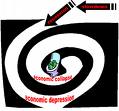20,000 Jobs Lost in US as Official Unemployment Rate Falls
Revised figures show 8.7 million jobs lost since December 2007

The official US unemployment rate fell to 9.7 percent in January, despite 20,000 jobs lost, according to monthly figures for December released Friday by the Labor Department.
The number of jobs, which the labor department called “essentially unchanged,” was affected by a number of contingent events, including the hiring of 9,000 temporary workers by the federal government to help with the 2010 census and the “inventory bounce” that took place in December.
The number of jobs lost comes on top of a sharply lower starting point than previously reported. On the basis of revised figures, the Labor Department now shows that a staggering 8.4 million jobs have been wiped out since December 2007, by far the worst downturn since the Great Depression.
The number of jobs lost in 2009 alone was revised upwards by about 600,000, including an increase in 11 out of 12 months. In particular, December’s figures were revised upward to show that the economy lost 150,000 jobs that month, instead of the 85,000 initially reported.
The unemployment rate, which is calculated on the basis of a separate survey, fell from 10 percent in December. One factor behind the discord between the jobs and unemployment numbers comes from the fact that the unemployment rate is very heavily adjusted for the fall-off in economic activity that usually happens in January. If one disregards this “seasonal adjustment,” there were 16.1 million unemployed people in January, up from 14.7 million in December. The non-seasonally adjusted unemployment rate actually rose sharply from 9.7 percent in December to 10.6 percent in January.
The improvement in the headline unemployment rate was nevertheless seized on by the media and Democratic Party to proclaim imminent recovery. “What a difference a year makes,” exclaimed Representative Carolyn Maloney, a Democrat from New York. “Today’s employment report … provides fresh evidence that the labor market has stabilized and our nation has turned a corner.”
Many economic commentators were decidedly less upbeat. When asked in a Bloomberg.com interview if investors will respond positively to claims of economic recovery, Anthony Crescenzi, a senior strategist at bond firm Pimco, replied simply: “No.” He said that such triumphalism is intended for political purposes, but Crescenzi’s peers did not “put a lot of weight” on claims of imminent recovery.
Crescenzi added, “We’ve seen Washington in high gear recently trying to paint a different picture of the economy,” but “the market understands that the underlying forces on the economy are still quite weak.”
Ethan Harris of Bank of America and Merrill Lynch, told Bloomberg.com, “The drop in the unemployment rate here is a bit of a fluke,” and that “this is a very choppy and somewhat disappointing report.”
The contradiction in the latest figures has also raised doubts about the impartiality of the official data. “The message is, you can’t believe what they tell you,” Joshua Shapiro, chief United States economist at MFR Inc, told theNew York Times. “Everyone goes crazy over today’s number, but history has been rewritten. Things are not comparable from month to month.”
In the longer term, the fall in the unemployment rate is related to workers dropping out of the labor force because they have given up looking for work. Since May of last year, the labor force has shrunk by about 1.8 million, amounting to over 1 percent of the previously working population.
In January, there were 2.5 million “marginally attached” workers, who would like to work but had not looked for a job in the previous four weeks. The number of such workers had grown by 409,000 from a year before. This figure is not seasonally adjusted.
Discouraged workers—a group within marginally attached workers—surged over 100,000 in January to 1.1 million, up from 734,000 a year earlier. These workers said that they stopped looking for work primarily because no jobs were available, instead of other reasons, like wanting to attend college.
The number of such workers topped one million for the first time in January, and last month’s increase was the sharpest since the start of the recession.
Young people were among the worst off, with the official unemployment rate for teenagers holding at 26.4 percent.
Long term unemployment also increased, with the number of people unemployed for over 27 weeks setting a new record, hitting 6.3 million, up from 6.1 million in December.
Retail trade posted an increase of 42,000 jobs, while manufacturing increased by 11,000. But this was outweighed by the elimination of 75,000 construction jobs. The government sector also showed a net loss of 8,000 jobs, as losses from state budget cuts outweigh temporary hiring for the census. Some 40,000 were eliminated in state and local government.
The loss of 20,000 jobs includes the growth of temporary jobs, about 52,000 of which were created in January. Since September 2009, 247,000 new temporary positions have been created, while the overall number of jobs has declined by 242,000.
Whatever jobs are created are not “going to be the type of high-paying jobs we like to see, it’s not going to full-time jobs; it’ll be part-time and contract labor,” said Ellen Zentner, senior US macro economist at the Bank of Tokyo.
Even as job losses mount, more work is being squeezed out of the workers who remain employed. Another recent report showed that, in the fourth quarter of last year, companies increased productivity, or the amount of work they can squeeze from each worker without paying more, by around 6 percent.

